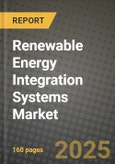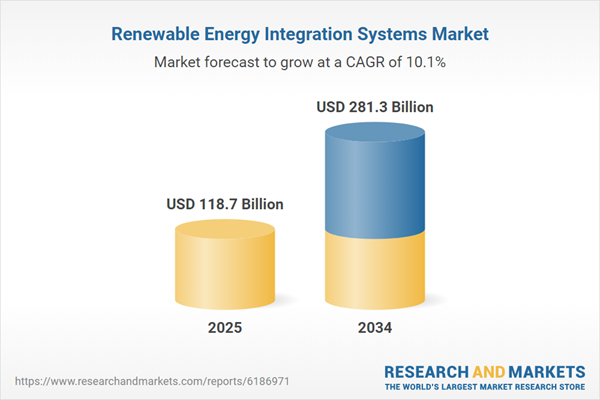The Renewable Energy Integration Systems Market is becoming increasingly critical as countries transition toward cleaner energy sources. These systems facilitate the seamless incorporation of renewable power - such as solar, wind, and hydro - into existing electricity grids while maintaining grid stability, reliability, and efficiency. They encompass a broad array of technologies, including advanced energy management systems, smart inverters, grid-forming converters, storage solutions, demand response tools, and digital monitoring platforms. The variability and intermittency of renewable energy necessitate robust integration strategies to manage real-time balancing, forecasting, voltage regulation, and frequency control. Utilities, independent power producers (IPPs), and grid operators rely on these systems to accelerate decarbonization while avoiding infrastructure bottlenecks and blackouts. With global energy systems rapidly evolving and renewable energy penetration increasing, integration technologies are emerging as the linchpin of next-generation, resilient power networks.
The renewable energy integration systems market witnessed considerable expansion as renewable installations surged globally. Utilities in Europe and North America adopted AI-based grid management systems to dynamically balance fluctuating inputs from solar and wind farms. Energy storage systems, particularly battery energy storage, were widely deployed in tandem with integration platforms to mitigate output variability and provide frequency response. Nations like India, Australia, and Brazil made significant progress in modernizing grid codes to accommodate higher renewable penetration, opening up new demand for smart inverters and real-time energy monitoring tools. Additionally, virtual power plants (VPPs) gained momentum as distributed energy resources (DERs) were aggregated and controlled via centralized software platforms. Pilot projects integrating electric vehicle (EV) charging infrastructure with renewable supply also gained attention, emphasizing the growing need for integrated load management solutions. Government incentives, public-private partnerships, and cross-sector collaborations defined much of the investment landscape in 2024.
The renewable energy integration systems market is poised for accelerated growth as energy systems become more complex and decentralized. Innovations in grid-forming inverters, power electronics, and hybrid integration platforms will enhance grid resilience, allowing networks to operate effectively even during disturbances. The role of artificial intelligence and predictive analytics will expand, offering real-time control and automation to maintain balance amid highly variable inputs. Cross-border interconnection projects and supergrid concepts will emerge as regions work to optimize renewable generation across geographies. Integration of distributed solar, wind, and storage at the residential and community level will be supported by smart meters and two-way communication infrastructure. Additionally, digital twins and simulation tools will enable utilities to model grid behavior and stress-test integration strategies. Regulatory alignment and investment in transmission modernization will be essential for unlocking the full potential of renewable integration technologies in the coming years.
Key Insights: Renewable Energy Integration Systems Market
- AI and machine learning are increasingly being used for real-time grid balancing, predictive forecasting, and energy flow optimization in renewable-rich networks.
- Virtual power plants (VPPs) are enabling decentralized integration by aggregating and controlling distributed energy assets through centralized digital platforms.
- Advanced smart inverters and grid-forming converters are enhancing voltage and frequency stability in networks with high renewable penetration.
- Integration of EV charging infrastructure with renewable generation is prompting the development of dynamic load management and bi-directional energy flow systems.
- Cloud-based energy management systems are supporting remote monitoring, control, and analytics for multi-site renewable energy portfolios.
- Rising global deployment of intermittent renewable energy sources is creating urgent demand for grid integration and stability solutions.
- Government mandates and incentive programs are supporting the development and deployment of smart grid and energy storage infrastructure.
- Decentralization of energy systems and the growth of prosumers are driving adoption of real-time energy management and DER integration platforms.
- Increasing electricity demand and electrification of transport and industry are necessitating more flexible and resilient power distribution networks.
- Legacy grid infrastructure, lack of interoperability standards, and regulatory fragmentation across regions hinder seamless integration of renewable energy technologies at scale.
Renewable Energy Integration Systems Market Segmentation
By Components
- Hardware
- Software
- Services
By Power Sources
- Wind power
- Solar power
- Hydro power
By End-User
- Residential Consumers
- Commercial Consumers
- Industrial Consumers
- Government Agencies
Key Companies Analysed
- Hitachi Ltd.
- Huawei Technologies Co. Ltd.
- Siemens AG
- General Electric Renewable Energy LLC
- Schneider Electric SE
- ASEA Brown Boveri Ltd.
- Toshiba Corporation
- Exelon Generation Company LLC
- Vestas Wind Systems AS
- Emerson Electric Co.
- Delta Electronics Inc.
- Sungrow Power Supply Co. Ltd.
- Enercon GmbH
- SolarEdge Technologies Inc.
- Enphase Energy
- Advanced Energy Industries Inc.
- SMA Solar Technology AG
- Fronius International GmbH
- Cyber Power Systems Inc.
- Nidec Industrial Solutions
- Kaco New Energy GmbH
- FlexGen Power Systems
- Doosan GridTech
- Voltus Inc.
- Ideal Power Inc.
Renewable Energy Integration Systems Market Analytics
The report employs rigorous tools, including Porter’s Five Forces, value chain mapping, and scenario-based modeling, to assess supply-demand dynamics. Cross-sector influences from parent, derived, and substitute markets are evaluated to identify risks and opportunities. Trade and pricing analytics provide an up-to-date view of international flows, including leading exporters, importers, and regional price trends.Macroeconomic indicators, policy frameworks such as carbon pricing and energy security strategies, and evolving consumer behavior are considered in forecasting scenarios. Recent deal flows, partnerships, and technology innovations are incorporated to assess their impact on future market performance.
Renewable Energy Integration Systems Market Competitive Intelligence
The competitive landscape is mapped through proprietary frameworks, profiling leading companies with details on business models, product portfolios, financial performance, and strategic initiatives. Key developments such as mergers & acquisitions, technology collaborations, investment inflows, and regional expansions are analyzed for their competitive impact. The report also identifies emerging players and innovative startups contributing to market disruption.Regional insights highlight the most promising investment destinations, regulatory landscapes, and evolving partnerships across energy and industrial corridors.
Countries Covered
- North America - Renewable Energy Integration Systems market data and outlook to 2034
- United States
- Canada
- Mexico
- Europe - Renewable Energy Integration Systems market data and outlook to 2034
- Germany
- United Kingdom
- France
- Italy
- Spain
- BeNeLux
- Russia
- Sweden
- Asia-Pacific - Renewable Energy Integration Systems market data and outlook to 2034
- China
- Japan
- India
- South Korea
- Australia
- Indonesia
- Malaysia
- Vietnam
- Middle East and Africa - Renewable Energy Integration Systems market data and outlook to 2034
- Saudi Arabia
- South Africa
- Iran
- UAE
- Egypt
- South and Central America - Renewable Energy Integration Systems market data and outlook to 2034
- Brazil
- Argentina
- Chile
- Peru
Research Methodology
This study combines primary inputs from industry experts across the Renewable Energy Integration Systems value chain with secondary data from associations, government publications, trade databases, and company disclosures. Proprietary modeling techniques, including data triangulation, statistical correlation, and scenario planning, are applied to deliver reliable market sizing and forecasting.Key Questions Addressed
- What is the current and forecast market size of the Renewable Energy Integration Systems industry at global, regional, and country levels?
- Which types, applications, and technologies present the highest growth potential?
- How are supply chains adapting to geopolitical and economic shocks?
- What role do policy frameworks, trade flows, and sustainability targets play in shaping demand?
- Who are the leading players, and how are their strategies evolving in the face of global uncertainty?
- Which regional “hotspots” and customer segments will outpace the market, and what go-to-market and partnership models best support entry and expansion?
- Where are the most investable opportunities - across technology roadmaps, sustainability-linked innovation, and M&A - and what is the best segment to invest over the next 3-5 years?
Your Key Takeaways from the Renewable Energy Integration Systems Market Report
- Global Renewable Energy Integration Systems market size and growth projections (CAGR), 2024-2034
- Impact of Russia-Ukraine, Israel-Palestine, and Hamas conflicts on Renewable Energy Integration Systems trade, costs, and supply chains
- Renewable Energy Integration Systems market size, share, and outlook across 5 regions and 27 countries, 2023-2034
- Renewable Energy Integration Systems market size, CAGR, and market share of key products, applications, and end-user verticals, 2023-2034
- Short- and long-term Renewable Energy Integration Systems market trends, drivers, restraints, and opportunities
- Porter’s Five Forces analysis, technological developments, and Renewable Energy Integration Systems supply chain analysis
- Renewable Energy Integration Systems trade analysis, Renewable Energy Integration Systems market price analysis, and Renewable Energy Integration Systems supply/demand dynamics
- Profiles of 5 leading companies - overview, key strategies, financials, and products
- Latest Renewable Energy Integration Systems market news and developments
Additional Support
With the purchase of this report, you will receive:- An updated PDF report and an MS Excel data workbook containing all market tables and figures for easy analysis.
- 7-day post-sale analyst support for clarifications and in-scope supplementary data, ensuring the deliverable aligns precisely with your requirements.
- Complimentary report update to incorporate the latest available data and the impact of recent market developments.
This product will be delivered within 1-3 business days.
Table of Contents
Companies Mentioned
- Hitachi Ltd.
- Huawei Technologies Co. Ltd.
- Siemens AG
- General Electric Renewable Energy LLC
- Schneider Electric SE
- ASEA Brown Boveri Ltd.
- Toshiba Corporation
- Exelon Generation Company LLC
- Vestas Wind Systems AS
- Emerson Electric Co.
- Delta Electronics Inc.
- Sungrow Power Supply Co. Ltd.
- Enercon GmbH
- SolarEdge Technologies Inc.
- Enphase Energy
- Advanced Energy Industries Inc.
- SMA Solar Technology AG
- Fronius International GmbH
- Cyber Power Systems Inc.
- Nidec Industrial Solutions
- Kaco New Energy GmbH
- FlexGen Power Systems
- Doosan GridTech
- Voltus Inc.
- Ideal Power Inc.
Table Information
| Report Attribute | Details |
|---|---|
| No. of Pages | 160 |
| Published | October 2025 |
| Forecast Period | 2025 - 2034 |
| Estimated Market Value ( USD | $ 118.7 Billion |
| Forecasted Market Value ( USD | $ 281.3 Billion |
| Compound Annual Growth Rate | 10.0% |
| Regions Covered | Global |
| No. of Companies Mentioned | 25 |









